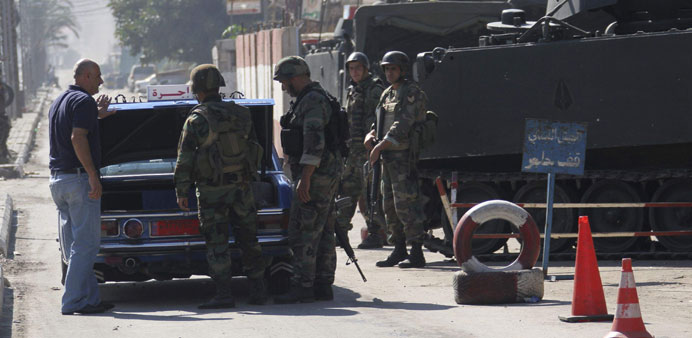AFP/Tripoli, Lebanon
Lebanon’s army began deploying yesterday in the northern city of Tripoli after 14 people were killed and more than 80 wounded in a week of bloodshed, an AFP reporter said.
The fighting, between supporters and opponents of Syria’s regime, has been concentrated in the Bab al-Tebbaneh and Jabal Mohsen districts of Tripoli, Lebanon’s second city.
The reporter said tanks and jeeps entered the northern sector of Bab al-Tebbaneh but their progress was slowed by burning tyres and sniper fire, to which the troops responded.
Three soldiers were wounded in the fighting, according to the reporter and security officials.
A security official said the army had also deployed in Jabal Mohsen, which adjoins Bab al-Tebbaneh.
Residents of Bab al-Tebbaneh support the revolt against Syrian President Bashar al-Assad, while those in Jabal Mohsen back Assad.
They have fought frequently since the Syrian conflict erupted in March 2011.
Acting Prime Minister Najib Mikati said on Saturday that “security forces will take every step to put an end to the violence and chaos” in the city. “They will be strict and impartial.”
But residents of Syria Street, which separates the two rival neighbourhoods, were sceptical.
“This is all a joke. It is the eighteenth time since May 2008 that they come to help. In fact, the army makes a small tour and then leaves. There is no solution,” said Mustafa al-Hajj, a 69-year-old retiree.
“In the past eight days, 400 families have left Syria Street, including my own. We sleep under the stars, me, my wife and our three children, in a park in the city,” he said.
“Each month it’s the same thing.”
Since the start of the latest violence, six residents of Jabal Mohsen, where the majority adhere to the same Alawite branch of Shia Islam as Assad, have been killed, while eight residents of mainly-Sunni Bab al-Tebbaneh have died.
Tripoli is home to 200,000 people, 80% of whom are Sunni Muslims, 6-7% Alawites and the rest Christians.
Despite being a minority in the city, the Alawite residents of Jabal Mohsen have been able to hold their own in the clashes because their neighbourhood occupies higher ground and they are better organised than the Sunnis in Bab al-Tebbaneh.
The latest round of fighting broke out on October 21 as Lebanese television aired an interview with Assad, in which he said the time is not ripe for a peace conference to try to resolve the 31-month conflict.
Assad also said he was ready to run for re-election in 2014.
The violence prompted many residents to flee the two neighbourhoods, and schools and universities have been closed since the middle of last week.
Lebanon is deeply divided over the Syrian war, a rift that has widened since the Lebanese Shia movement Hezbollah admitted in May it was sending fighters into Syria to support Assad’s troops.
Small radical Sunni organisations have also sent men across the border to fight alongside rebels.
Lebanon was dominated politically and militarily by Damascus for 30 years until 2005.

Lebanese army soldiers man a checkpoint in Tripoli yesterday.


